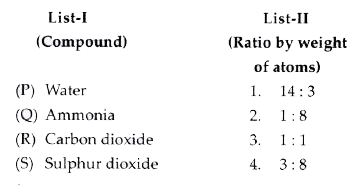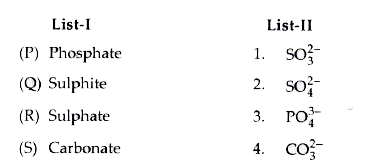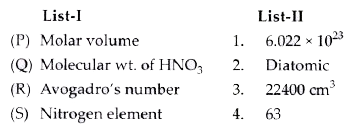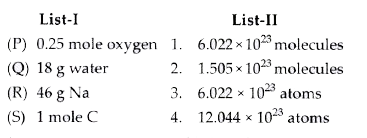EXERCISE ( Comprehension Type PASSAGE-III ) from MTG IIT JEE FOUNDATION ATOMS, MOLECULES AND ATOMIC STRUCTURE for Class 8
| Class 8 | CHEMISTRY |
| Chapter | ATOMS, MOLECULES AND ATOMIC STRUCTURE |
| MTG IIT JEE FOUNDATION | EXERCISE ( Comprehension Type PASSAGE-III ) |
| Medium | English |
| Academic Year | 2023-2024 |
Question 48
Which of the following statements are correct about α (alpha) particle scattering experiment?
(i) Most of the fast moving a-particles passed straight through gold foil.
(ii) Some of a-particles were deflected by the foil by small angles.
(iii) Surprisingly one out of every 10 particles appeared to reboundView SolutionQuestion 67
The percentage composition of elements in a compound is calculated from the molecular formula of the compound. The molecular mass of a compound is calculated from the atomic masses of the various elements present in the compound. The percentage of mass of each element is then calculated with the help of the following relation. Percentage mass of the element in the compound.
Mass of the elementMass of the compound
What is the percentage of calcium in calcium carbonate?View SolutionQuestion 68
The percentage composition of elements in a compound is calculated from the molecular formula of the compound. The molecular mass of a compound is calculated from the atomic masses of the various elements present in the compound. The percentage of mass of each element is then calculated with the help of the following relation. Percentage mass of the element in the compound.
Mass of the elementMass of the compound
Calculate the mass of carbon present in 2 g of carbon dioxide. View SolutionQuestion 69
The percentage composition of elements in a compound is calculated from the molecular formula of the compound. The molecular mass of a compound is calculated from the atomic masses of the various elements present in the compound. The percentage of mass of each element is then calculated with the help of the following relation. Percentage mass of the element in the compound.
Mass of the elementMass of the compound
What is the molecular mass of calcium chloride?View SolutionQuestion 70
The percentage composition of elements in a compound is calculated from the molecular formula of the compound. The molecular mass of a compound is calculated from the atomic masses of the various elements present in the compound. The percentage of mass of each element is then calculated with the help of the following relation. Percentage mass of the element in the compound.
Mass of the elementMass of the compound
Percentage of S in aluminium sulphate isView SolutionQuestion 71
In chemistry, 'mole' is an essential tool for the chemical calculations. It is a basic SI unit adopted by the 14th general conference on weights and measurements in 1971. A mole contains as many elementary particles as the number of atoms present in 12 g of 12C . 1 mole of a gas at STP occupies 22.4 litre volume. Molar volume of solids and liquids is not definite. Molar mass of a substance is also called gram-atomic mass or gram molecular mass. The virtual meaning of mole is plenty, heap or the collection of large numbers. 1 mole of a substance contains 6.022×1023 elementary particles like atom or molecule. Atomic mass unit (amu) is the unit of atomic mass, e.g., atomic mass of single carbon is 12 amu.
The mass of one molecule of water is approximatelyView SolutionQuestion 72
In chemistry, 'mole' is an essential tool for the chemical calculations. It is a basic SI unit adopted by the 14th general conference on weights and measurements in 1971. A mole contains as many elementary particles as the number of atoms present in 12 g of 12C . 1 mole of a gas at STP occupies 22.4 litre volume. Molar volume of solids and liquids is not definite. Molar mass of a substance is also called gram-atomic mass or gram molecular mass. The virtual meaning of mole is plenty, heap or the collection of large numbers. 1 mole of a substance contains 6.022×1023 elementary particles like atom or molecule. Atomic mass unit (amu) is the unit of atomic mass, e.g., atomic mass of single carbon is 12 amu.
How many atoms are present in 49 g of H2SO4? View SolutionQuestion 73
In chemistry, 'mole' is an essential tool for the chemical calculations. It is a basic SI unit adopted by the 14th general conference on weights and measurements in 1971. A mole contains as many elementary particles as the number of atoms present in 12 g of 12C . 1 mole of a gas at STP occupies 22.4 litre volume. Molar volume of solids and liquids is not definite. Molar mass of a substance is also called gram-atomic mass or gram molecular mass. The virtual meaning of mole is plenty, heap or the collection of large numbers. 1 mole of a substance contains 6.022×1023 elementary particles like atom or molecule. Atomic mass unit (amu) is the unit of atomic mass, e.g., atomic mass of single carbon is 12 amu.
XL N2 , gas at STP contains 3×1022 molecules. The number of molecules in x L ozone at STP will beView SolutionQuestion 74
In chemistry, 'mole' is an essential tool for the chemical calculations. It is a basic SI unit adopted by the 14th general conference on weights and measurements in 1971. A mole contains as many elementary particles as the number of atoms present in 12 g of 12C . 1 mole of a gas at STP occupies 22.4 litre volume. Molar volume of solids and liquids is not definite. Molar mass of a substance is also called gram-atomic mass or gram molecular mass. The virtual meaning of mole is plenty, heap or the collection of large numbers. 1 mole of a substance contains 6.022×1023 elementary particles like atom or molecule. Atomic mass unit (amu) is the unit of atomic mass, e.g., atomic mass of single carbon is 12 amu.
The mass of 1 amu is approximatelyView SolutionQuestion 75
According to Dalton's atomic theory, all matter whether an element, a compound or a mixture is composed of small particles called atoms which can neither be created nor destroyed during a chemical reaction. Dalton's theory provides a simple explanation for the laws of chemical combination. He used his theory to explain law of conservation of masses, law of constant proportions and law of multiple proportions, based on various postulates of the theory. Dalton was the first scientist to use the symbols for the elements in a very specific sense. When he used a symbol for an element he also meant a definite quantity of that element, that is one atom of that element.
Which postulate of Dalton's atomic theory is the result of the law of conservation of mass?View SolutionQuestion 76
According to Dalton's atomic theory, all matter whether an element, a compound or a mixture is composed of small particles called atoms which can neither be created nor destroyed during a chemical reaction. Dalton's theory provides a simple explanation for the laws of chemical combination. He used his theory to explain law of conservation of masses, law of constant proportions and law of multiple proportions, based on various postulates of the theory. Dalton was the first scientist to use the symbols for the elements in a very specific sense. When he used a symbol for an element he also meant a definite quantity of that element, that is one atom of that element.
Which postulate of Dalton's atomic theory explains law of definite proportions? View SolutionQuestion 77
According to Dalton's atomic theory, all matter whether an element, a compound or a mixture is composed of small particles called atoms which can neither be created nor destroyed during a chemical reaction. Dalton's theory provides a simple explanation for the laws of chemical combination. He used his theory to explain law of conservation of masses, law of constant proportions and law of multiple proportions, based on various postulates of the theory. Dalton was the first scientist to use the symbols for the elements in a very specific sense. When he used a symbol for an element he also meant a definite quantity of that element, that is one atom of that element.
When 5 g calcium is burnt in 2 g oxygen, 7 g of calcium oxide is produced. When 5 g of calcium is burnt in 20 g of oxygen, then also 7 g of calcium oxide is produced. Which law of chemical combination is being followed?View SolutionQuestion 78
PA S S A G E -I V : The molecular mass of a substance is the relative mass of its molecule as compared with the mass of a carbon-12 atom taken as 12 units. The molecular mass of a substance indicates the number of times one molecule of a substance is heavier than 112 of C-12 atom. It is equal to the sum of atomic masses of all the atoms present in a molecule. Depending on the number of atoms of same or different elements present in the molecule, it can be monoatomic, diatomic, triatomic, tetratomic or a polyatomic molecule.
Which is an example of a polyatomic molecule?View SolutionQuestion 79
The molecular mass of a substance is the relative mass of its molecule as compared with the mass of a carbon-12 atom taken as 12 units. The molecular mass of a substance indicates the number of times one molecule of a substance is heavier than 112 th of C-12 atom. It is equal to the sum of atomic masses of all the atoms present in a molecule. Depending on the number of atoms of same or different elements present in the molecule, it can be monoatomic, diatomic, triatomic, tetraatomic or a poly-atomic molecule.
Carbon dioxide, hydrogen sulphide, calcium chloride and sodium oxide are examples of View SolutionQuestion 80
The molecular mass of a substance is the relative mass of its molecule as compared with the mass of a carbon-12 atom taken as 12 units. The molecular mass of a substance indicates the number of times one molecule of a substance is heavier than 112 th of C-12 atom. It is equal to the sum of atomic masses of all the atoms present in a molecule. Depending on the number of atoms of same or different elements present in the molecule, it can be monoatomic, diatomic, triatomic, tetraatomic or a poly-atomic molecule.
View Solution
All Exercises from MTG IIT JEE FOUNDATION Class 8 CHEMISTRY ATOMS, MOLECULES AND ATOMIC STRUCTURE
- EXERCISE ( COMPREHENSION TYPE PASSAGE-I )
- EXERCISE ( COMPREHENSION TYPE PASSAGE-II )
- EXERCISE ( COMPREHENSION TYPE PASSAGE-III )
- EXERCISE ( COMPREHENSION TYPE PASSAGE-IV )
- EXERCISE ( INTEGER/NUMERICAL VALUE TYPE)
- EXERCISE (ASSERTION & REASON TYPE)
- EXERCISE (MATCH THE FOLLOWING)
- EXERCISE (MULTIPLE CHOICE QUESTIONS)
- ILLUSTRATION
- SOLVED EXAMPLES






